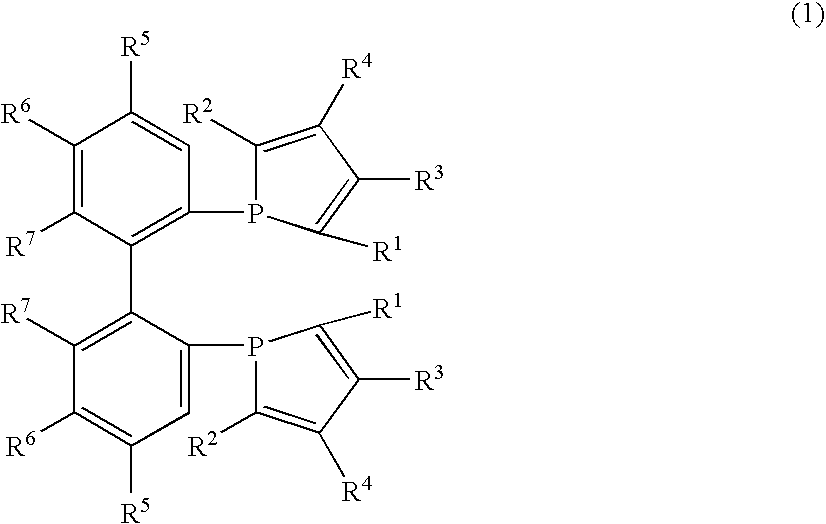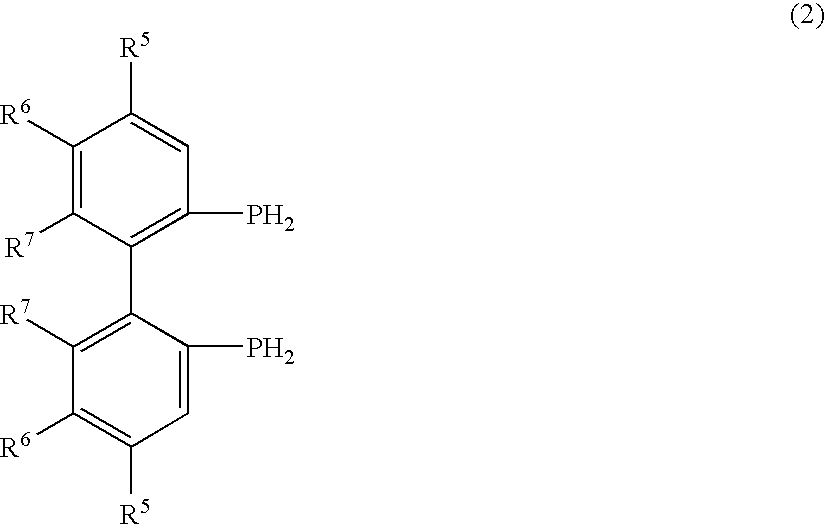Phosphine compounds, transition metal complexes with the compounds contained as ligands therein, and asymmetric synthesis catalysts containing the complexes
- Summary
- Abstract
- Description
- Claims
- Application Information
AI Technical Summary
Benefits of technology
Problems solved by technology
Method used
Image
Examples
example 1
Synthesis of (+)-(4′,4′-bi-1,3-benzodixol)-5,5′-diylbis(2,5-dime thylphosphole)((+)-MP2-SEGPHOS)
(a) Synthesis of (−)-(4′,4′-bi-1,3-benzodixol)-5,5′-diylbis(diethylpho sphonate)((−)-5′)
[0105] To a mixture of a diphosphate (6) (204.5 g, 478 mmol) which had been obtained by the procedure disclosed in Example 4 of JP 2000-16998 A, and (−)-ditoluoyltartaric acid (153.6 g, 478 mmol), butyl acetate (510 mL) was added, followed by heating to 105° C. The reaction mixture was allowed to cool down to room temperature. After stirred overnight, the resulting solid was collected by filtration. Dichloromethane (1,000 mL) and a 1 mol / L aqueous solution of sodium hydroxide (1,000 mL) were added. The resulting mixture was stirred for 0.5 hour, and was then allowed to separate into layers. The organic layer was washed successively with water and a saturated aqueous solution of sodium chloride, and was then dried over anhydrous sodium sulfate. The solvent was distilled off to afford the title compoun...
example 2
Synthesis of (+)-[(4′,4′-bi-1,3-benzodixol)-5,5′-diyl]bis(2,5-di methylphosphole)((+)-P3-SEGPHOS)
[0118] (−)-H2-SEGPHOS (3.0 g, 9.8 mmol) and 2,4-diphenylbutadiyne (3.96 g, 19.6 mmol) were dissolved with toluene (90 mL) and tetrahydrofuran (3 mL), followed by cooling to 0° C. Into the mixture, a 1.6 mol / L solution of n-butyllithium in hexane (2.45 mL, 3.92 mmol) was added dropwise. Subsequent to stirring the reaction mixture at 0° C. for 2 hours, the reaction mixture was heated to room temperature and then stirred further for 2 hours. Methanol was charged, and then, the solvent was distilled off. The residue was purified by silica gel chromatography to afford the title compound (3.29 g, yield: 47%, optical purity: 99.7% ee). Incidentally, the optical purity was measured using HPLC (Chiralcel OD) equipped with an optically active column.
[0119] EI-MS: m / z 711 (M+1)+
[0120]1H NMR (CDCl3) δ: 5.23(2H, d, J=1.6 Hz), 5.57(2H, d, J=1.6 Hz), 6.62(2H, d, J=8.2 Hz), 6.69(2H, td, J=2.2, 8.2 Hz)...
example 3
Synthesis of [Rh(cod)((+)-MP2-SEGPHOS)]OTf
[0123] (+)-MP2-SEGPHOS (50 mg, 0.108 mmol) was dissolved in dichloromethane (3 mL), and the resulting solution was added dropwise into a mixture of [Rh(cod)2]OTf (50.6 mg, 0.108 mmol) and dichloromethane (3 mL). Subsequent to stirring at room temperature for 4 hours, the solvent was distilled off under reduced pressure. The solid was washed three times with 5 ml of hexane, and then dried under reduced pressure to afford the title compound (90 mg).
[0124]31P NMR(CD2Cl2) δ: 39.6(d, J=130.5 Hz)
PUM
| Property | Measurement | Unit |
|---|---|---|
| Purity | aaaaa | aaaaa |
| Optical activity | aaaaa | aaaaa |
Abstract
Description
Claims
Application Information
 Login to View More
Login to View More - R&D
- Intellectual Property
- Life Sciences
- Materials
- Tech Scout
- Unparalleled Data Quality
- Higher Quality Content
- 60% Fewer Hallucinations
Browse by: Latest US Patents, China's latest patents, Technical Efficacy Thesaurus, Application Domain, Technology Topic, Popular Technical Reports.
© 2025 PatSnap. All rights reserved.Legal|Privacy policy|Modern Slavery Act Transparency Statement|Sitemap|About US| Contact US: help@patsnap.com



